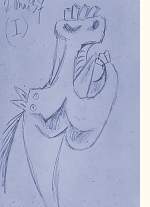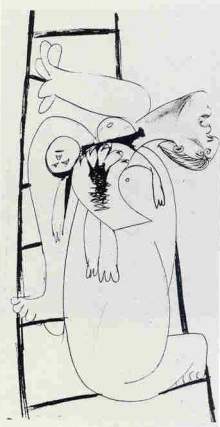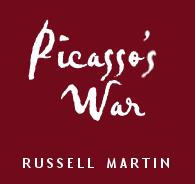|
|
 Picasso sketched the first five of his May Day studies in pencil on blue drawing paper, executing each one in only a minute or two. From the outset, images of the corrida flooded into his consciousness as he considered how to respond to the atrocity that occurred five days before. Even in the very first image that spilled from his fingers, a wounded horse and defiant bull were present, as were the head and arm of a woman leaning from a window and holding a lamp in her extended hand in order to light the scene. The horse and bull would be modified many times before the studies were translated onto canvas and the painting was complete in early June
Picasso sketched the first five of his May Day studies in pencil on blue drawing paper, executing each one in only a minute or two. From the outset, images of the corrida flooded into his consciousness as he considered how to respond to the atrocity that occurred five days before. Even in the very first image that spilled from his fingers, a wounded horse and defiant bull were present, as were the head and arm of a woman leaning from a window and holding a lamp in her extended hand in order to light the scene. The horse and bull would be modified many times before the studies were translated onto canvas and the painting was complete in early June their positions, depictions, and attitudes changing often as the work inexorably assumed creative weight. But the observing woman, her profile once more an unmistakable likeness of Marie-Thérèse, immediately assumed such vital symbolic and compositional importance for the artist that she only very subtly would change throughout dozens of subsequent sketches and in the several states the final painting would assume as well. their positions, depictions, and attitudes changing often as the work inexorably assumed creative weight. But the observing woman, her profile once more an unmistakable likeness of Marie-Thérèse, immediately assumed such vital symbolic and compositional importance for the artist that she only very subtly would change throughout dozens of subsequent sketches and in the several states the final painting would assume as well.
 Although he, like most Parisians, by now had heard many conflicting details about the incident in Gernika, not once did Picasso experiment with images of airplanes, bombs, or exploding buildings on that first day or any other. It was his ongoing interest in the surrealistic linking of the conscious and unconscious that immediately turned him away from a documentary response to what had transpired; and also, he had not been truly interested in any sort of visual documentation since before the turn of the century, regardless of its subject. Perhaps more importantly, from those first days in May, Picasso found himself interested not so much in what the bombing and destruction of Gernika meant politically or even in humanitarian terms, but rather what they meant in metaphor. He wanted to address emotionally the destruction of his beloved homeland that was taking place both from within and without, and he already possessed a personal visual language with which to do so, one anchored in the violence, suffering, and passion of the corrida and its centuries-old tradition of making viudas, widows, out of the wives of the men who played out its pageantry. The civil war itself was a ghastly and gruesome pageant, it appeared to Picasso from France, one in which death appeared as terribly foreordained as it was inside the bullring.
Although he, like most Parisians, by now had heard many conflicting details about the incident in Gernika, not once did Picasso experiment with images of airplanes, bombs, or exploding buildings on that first day or any other. It was his ongoing interest in the surrealistic linking of the conscious and unconscious that immediately turned him away from a documentary response to what had transpired; and also, he had not been truly interested in any sort of visual documentation since before the turn of the century, regardless of its subject. Perhaps more importantly, from those first days in May, Picasso found himself interested not so much in what the bombing and destruction of Gernika meant politically or even in humanitarian terms, but rather what they meant in metaphor. He wanted to address emotionally the destruction of his beloved homeland that was taking place both from within and without, and he already possessed a personal visual language with which to do so, one anchored in the violence, suffering, and passion of the corrida and its centuries-old tradition of making viudas, widows, out of the wives of the men who played out its pageantry. The civil war itself was a ghastly and gruesome pageant, it appeared to Picasso from France, one in which death appeared as terribly foreordained as it was inside the bullring.
 In the second drawing of that Saturday, a small Pegasus appeared
In the second drawing of that Saturday, a small Pegasus appeared  similar to the fanciful winged horses Picasso remembered from the Spanish circus similar to the fanciful winged horses Picasso remembered from the Spanish circus  mounted on the back of a confident bull. In the third, three fantastic monsters that echoed his horrific depictions of Franco some months before made a single appearance before they were discarded. The fourth sketch was a primitive drawing of solely a standing horse mounted on the back of a confident bull. In the third, three fantastic monsters that echoed his horrific depictions of Franco some months before made a single appearance before they were discarded. The fourth sketch was a primitive drawing of solely a standing horse a child's image, as it were, that seemed designed to test how best to represent the equine figure a child's image, as it were, that seemed designed to test how best to represent the equine figure followed on a subsequent sheet of blue paper by a highly realistic sketch of a fallen horse, this one an illusion of a flesh-and-blood animal whose predicament was dynamically conveyed in its struggle to stand and whose pain was telegraphed by a terrified eye and gaping mouth. followed on a subsequent sheet of blue paper by a highly realistic sketch of a fallen horse, this one an illusion of a flesh-and-blood animal whose predicament was dynamically conveyed in its struggle to stand and whose pain was telegraphed by a terrified eye and gaping mouth.
Excerpted from Picasso's War by Russell Martin, Copyright© 2002 by Russell Martin.
Excerpted by permission of Dutton, a division of Penguin Putnam, Inc.
All rights reserved. No part of this excerpt may be reproduced or reprinted without permission in writing from the publisher.
|
|
 |
| |

|
|






